Namysłów
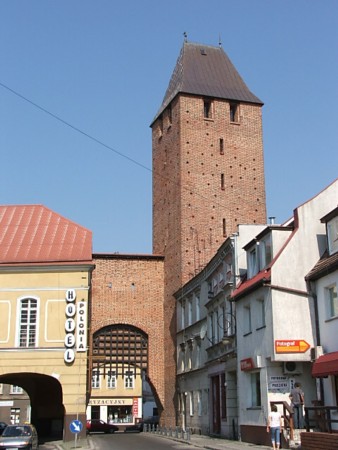
Namysłów. Kraków Gate with the Gate Tower (seen outside the city wall)
Distance
Population
16.358 (2007)
Location and history
The town of Namysłów is located in the northern part of Opole County, Silesia, north of Opole and east of Wrocław.
There are good road links to Brzeg, Oława, Oleśnica, Syców, Kępno and Kluczbork. The nearest airport is at Wrocław at a distance of 75 km.
A settlement in this place has been known since the 11th century. In 1249, the town was granted commercial property rights, granted by Prince Henry III of Wrocław, to whose principality the town belonged until 1294. In 1285, a Franciscan monastery was founded in Namysłów. For a few years at the beginning of the 14th century. was the city's capital of an independent principality. In 1321, Prince Konrad I of Oleśnica granted the city the privilege of brewing beer. Between 1342 and 1348, the city was mortgaged to the Polish king, Kazimierz the Great. In connection with a peace agreement in 1348 between Poland and the Czech Republic, the city came under the Czech Republic with the status of royal sanctuary. In 1350, the Czech king, Charles IV, initiated the building of a city wall around Namysłów. The construction of a foundation walled defense castle was begun in 1360; formerly a wooden building existed. Namysłów was besieged but not consumed by the Hussites. Three great fires destroyed the city in 1377, 1466 and 1483. Zikmund Lucemburský, son of Charles IV, in 1431 gave the city the right to strike coins, namely silver denarians.
In the 15th year. grew the importance of the city as a trade center; Moreover, the inhabitants were mainly employed as craftsmen, especially in the manufacture of clothing. In 1526, the city came under the Habsburgs. During the 30-year war, Namysłów was besieged and captured by the Swedes. Until the 17th century. the city played a role as a border fortress. In 1703, Emperor Leopold in Habsburg sold the castle to the Maltese Order; there was thus a commander's residence under the order until his secularization in 1810. Prussia assumed power in the city and the area in the year 1741.
During the Franco-Prussian War of 1806-07, Namysłów was for a long time occupied by French forces. The city's fortifications were demolished in 1868 and green areas were instead built. In 1868 there was a rail link to Wrocław and Kluczbork and in 1899 to Opole.
During the Second World War, a sub-camp was established in Namysłów during the concentration camp in Rogoźnica (Gross-Rosen) and three labor camps. In January 1945, Soviet forces invaded the city, and from April 1945 the local administration was left to Polish authorities. Immediately after the end of the war, approx. 6,500 Germans from the city and district moved to Germany, while new, Polish, newcomers came to the district from areas in the eastern part of the Polish Republic.
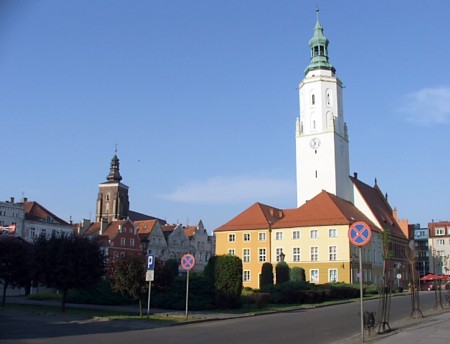
The square in Namysłów seen from the southwest corner. To the right is the town hall with the extensions around the tower, to the left the houses along the north side of the square and behind them is seen St. Peter and Paul's Church
Tourist attractions
Selected attractions:
Bymuren
The fortification of the city took place following orders from the Czech king, Charles IV, and was started in 1350. The city wall's foundation was made of field bricks, the rest of Gothic bricks with the use of burnt bricks up to 8 meters in height, and there were brick roofs at 2 meters in height . The wall thickness was approx. 2.2 m on the east side and slightly smaller on the north and south sides. Of the original city wall, which was fortified with 45 brick towers and gate towers, today significant parts are preserved as well as the Kraków gate tower and significant parts of four half-rounds and ten square brick towers. To the west, the city wall was built with the fortification of the castle. Two access gates were built: from the east the Polish Gate (or Kluczbork Gate, later the Krakow Gate) and from the West the German Gate (or the Brzeg or Wrocław Gate). This last gate was demolished in the second half of the 19th century. The still preserved Kraków gate tower has a square floor plan and is 6 storeys. The city wall was reinforced over time, thus in the northern and southern part were built half-round towers as well as two corner towers, called the Baker Tower and the Blacksmith Tower; the tower at the Kraków Gate was elevated. In order to improve the possibility of defense, in 1421 a deep trench was dug near the city wall. In the 15th year. was erected as an extension of the wall some smaller bastions from which to shoot the enemy from the side. In the middle of the 16th century. the fortification was further expanded with a whole system of earth bastions.
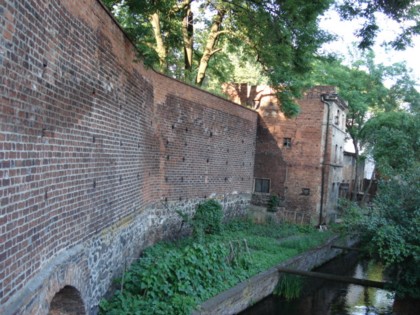
Namysłów. Section of the city wall
Borgen
In 1360, the current foundation-walled castle was built on the site of the former wooden-built castle (referred to as 1312). Originally, the castle had an irregular, oval floor plan, determined by the ancient fortifications of soil and wood. The area was approx. 1500 m2. The castle was built in brick (the lower parts, however, of field stone) and it was surrounded by a moat. There were three wings that were joined by the defensive wall. The oldest part of the castle is the northern wing. This central wing was on two floors and had three main rooms. The other two wings were built substantially later, the west wing after 1533 and the south wing in 1771. In 1534 a gate building was added.
In 1533, the castle was taken over by the Wroclaw City Council. In the 17th and 18th centuries. several renovation work was carried out, i.a. after a fire in 1658 and the devastation caused by the Prussian army in 1741. In the 19th century. a major rebuild was made. The castle had several owners over time. Thus, it belonged to the Maltese Order between 1703 and 1810 (see also above under the section on the history of the city). After being a state estate for a short time, the buildings came into private hands, and in 1895 they were purchased by German beer brewer August Haselbach, who since 1862 owned the local brewery, dating from 1536. The castle still belongs to the brewery.
In the courtyard is a beautifully decorated well dating from around 1600. In addition, the Gothic entrance to the main building, which is shaped like a protruding wall part on two floors, is noted.
The former Franciscan church
The church was erected at the end of the 13th century. and later remodeled during the Baroque period. After the secularization in 1810, the church building was used as a magazine for the brewery. It is a wooden ship's slate church; the chorus is considerably elongated and has a multi-sided finish. Of the monastery buildings, only part of the west wing is preserved.
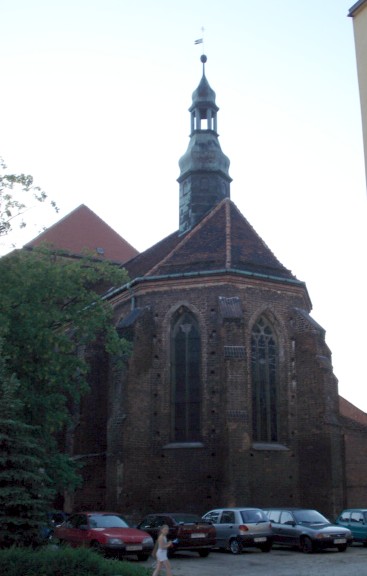
Namysłów. The former Franciscan church, seen from the east
St. Peter and Paul's Church (Kościół Św. Piotra i Pawła)
This church, which is the parish church of the city, is mentioned in the documents from the year 1278. In its present form, however, it was built after the year 1400. At the end of the 1400s the church was rebuilt after a fire. It is now a wooden ship's slate church, built of brick. The side ships run parallel to the choir and the whole has a multi-sided finish to the east. The impressive square floor tower is to the west. The tower is divided into four floors with strip friezes. The exterior of the church building is supported by aspirations. Inside, the end stones of the side ships are decorated with the motifs that also appear in the main ship: the head of Christ, the Czech lion, stars and rosettes. Among the most valuable works of art in the church is the large wooden cross with the Christ figure from the year 1500.
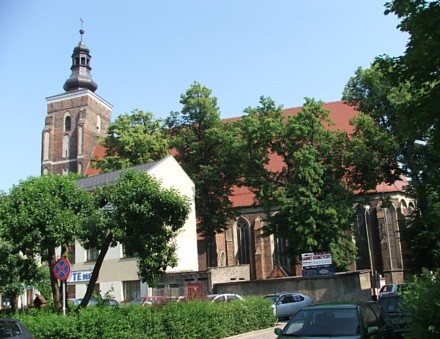
Namysłów. The parish church of Saint Peter and Paul's Church, seen from the south
City Hall
The building was originally constructed in the Gothic style in the 14th century. In the 16th, 18th and 19th centuries. an expansion and renewal occurred; from the south, west and north, building sections were added that surround the tower. The walls are of brick. The Town Hall tower has a square floor plan; however, the upper part is octagonal. The lower part of the tower dates from 1381-89, while the upper part is added after a fire in 1483. The tower is crowned with a helmet from 1695, in the late Renaissance style. In the building there are halls covered with three-part vaults.
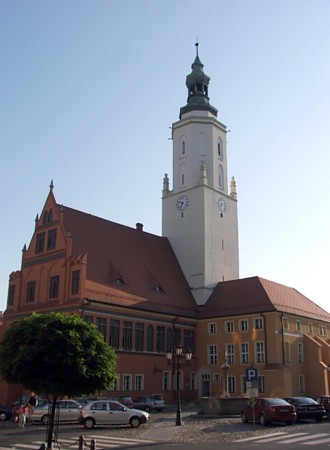
Namysłów. Town Hall in the square, seen from the northeast; the old town hall building is seen to the left of the tower
Krakow port
The city's eastern city gate and the gate tower, dating from the 14th century, are preserved. The gate was formerly called the Polish Gate (or Kluczbork Gate), later the Kraków Gate. The gate tower has a square floor plan and is on 6 floors with a height of 26 m. In 2006 renovations and reconstructions were carried out with regard to the drop grid, the tower helmet and the wooden built weights.
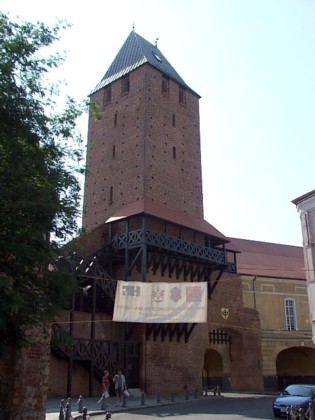
Namysłów. Kraków gate with gate tower and wall corridor (seen inside the city wall) (See also photo at top of page)
Old houses in the square
On the north side of the square are a number of old houses; most are from the 16th century, a simple one from the 17th century.
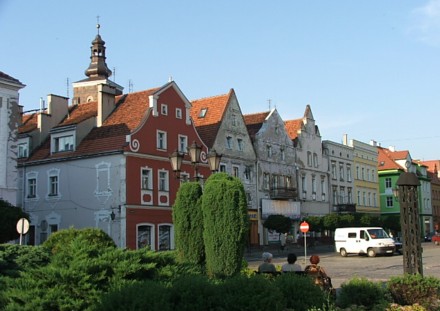
Namysłów. Old houses on the north side of the square. In the background you see Saint Peter and Paul's Church
Namysłów Brewery (Browar Namysłów)
The brewery is one of the oldest in Europe. In 1321, Prince Konrad I of Oleśnica granted the city of Namysłów a privilege for brewing beer. This is known from a document from the time when a painting and brewery business is mentioned in the city. According to the legend, the Polish king Kazimierz the Great was already drinking the local beer while staying at the castle – which, moreover, is in the brewery's area today. Today, the brewery combines modern technology with traditional methods; thus, fermentation continues in open fermentation vessels. The first real brewery was set up in 1536 – on the castle.
The current brewery was founded by the German brewer, August Haselbach, who in 1862 settled in the city. He bought the brewery formerly owned by the Maltese Order and expanded it into a modern enterprise. In 1895 Haselbach also bought the castle. The Haselbach family owned the company until 1944. Under its German name: Brauerei Haselbach, the brewery became widely known, and it became a model for other breweries, owned by the same family, throughout Germany.
After World War II, when the area became Polish again, the brewery switched to state ownership. In 1945, the brewery Namysłowskie Zakłady Piwowarsko-Słodownicze (Namysłów Brewery and Painting Company) was established, which in 1970 was incorporated into the Brewery and Painting business in Opole. In 1991, the Namysłów brewery became independent, establishing the company Browar Namysłów Sp. z oo In 1998, the Gostomski family became the largest co-owner of the company. The family affiliated US capital group, Chicago Poland Investment Group, bought all shares in 1999 and began an active modernization of the company in order to gain a larger market share. The brewery is now cooperating with the bottling company JAKO.
Today, the brewery utilizes 2 of the 3 wings on the castle. The brewery's main buildings are located next door to the castle, immediately south and southwest of this one. There are 200 employees in the company that produce approx. 1 million hectoliters of beer a year. The brewery's products (which currently include five beers – 2010) are not only sold in Poland but are also exported to several other countries, including the USA, Australia and Denmark.
During the summer season (from May to August), the brewery organizes a number of outdoor exhibitions in several cities in the Opole region and Lower Silesia, whose theme is the history of the brewery and the castle as well as the course of the beer production itself.
Tourist routes in Namysłów
There are five described routes for tourists, which you can follow to experience the main sights of the city. The routes can be followed either on foot, by bike or by car. The first of these routes is called “ring route”, following the city wall around the old city.
Surrounding Area
Through the district the river runs Widawa; at the shores of this clean stream are beavers and otters alike.
Another river is Stobrawa, which intersects the Stobrawa Landscape Park. Both the woodlands and the open countryside offer excellent hunting districts. Accommodation and lodging are offered, among other things. of several centers of agrotourism (farm holidays).
At the village of Michalice northeast of Namysłów, in connection with the Widawa River, a water reservoir with a length of 3 km and an area of 100 ha has been created for water sports.
The area offers angling, hunting and horse riding.
Many foreign companies have branches in the Namysłów district. USA, Germany, France and Denmark.
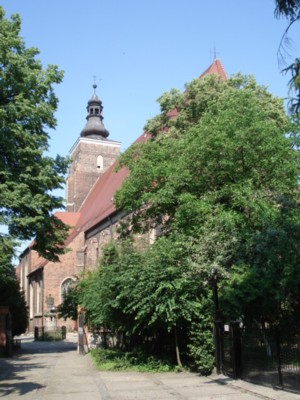
Namysłów. Saint Peter and Paul's Church, seen from the east
Accommodation
Booking.com
Namysłów – gmina z character (Polish, English, German, Czech, Hungarian, Romanian). Here also practical information for tourists
Other Internet sites and sources
Namysłów – gmina z character (Polish, English, German, Czech, Hungarian, Romanian)
Translated into English by Google Translate. Spangshus.dk accept no liability for any errors or omissions in translation.
Map

Rating
Search
Most used tags
churches (205) Castles (86) Monasteries (79) Town walls (74) Lakes (71) Town halls (67) Rivers (65) Castles1 (62) Mansions (55) Museums (51) Regional museums (38) Town gates (36) Abbey churches (35) Castle ruins (30) Cathedrals (26) Forests (25) Health resorts (24) Mounds (23) Water sports (23) National parks (22)Click for all tags
Denne side er også tilgængelig på dansk. This page and contents is (c) Copyright 2018- www.spangshus.dk. Based on Inviator software by ISCA Software